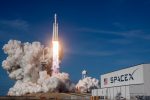Starlink is one of the most ambitious projects to ever be undertaken by a private enterprise. By the time of its completion, SpaceX will launch a constellation of low orbit, low-frequency satellites that promises to deliver cheap, latency-free broadband across the globe. It’s an incredible vision for the future, and Elon Musk and the SpaceX crew deserve all the accolades they’re getting for Starlink’s first round of successful launches.
Unfortunately, huge leaps forward also come with their fair share of sacrifices, and Starlink might just sacrifice the night sky for its goal. As of right now, there are 4,987 human-made satellites inhabiting a general space around Earth called the geocentric orbit. These satellites are rather small and range in distance from 240 kilometers away from Earth, all the way up to 36,200 kilometers.
Although this might seem like a lot of objects, the reality is that the surface area of the Earth is massive, and the diameter and depth of the geocentric orbit area is even larger. The majority of the night sky is taken up by empty space, and the orbit of satellites is well mapped and planned by astronomers.
Starlink will change this. Unlike other satellites, Starlink is a constellation design, meaning that a single launch can see as much as 60 individual satellites set up, all of them following each other in an interconnected train as they orbit. An individual train of Starlink satellites is closely followed by more strings, building an expansive web of tightly-packed objects that all inhabit the same low-level geocentric orbit.
Once, the vast, empty sky was only occasionally disrupted by a small disturbance, but there are now bright strings of highly-reflective satellites that create opaque trails in the night sky, and they pass through the sensitive astronomy cameras’ fields of view. This saturation of visual noise is a grave threat to ground-based astronomy, which relies on long-exposure photography in order to collect and filter the dim light of galaxies countless light-years away. Starlink satellite trains have already proven to be a great hindrance to astronomers, even in relatively low numbers.
Here’s the Starlink plagued DECam frame: #FieldOfSatTrails pic.twitter.com/TyFSJO9LKR
— Cliff Johnson (@lcjohnso) November 18, 2019
The first 122 Starlink satellites are noticeably reflective and have become infamous among astronomers for ruining vital long-exposure shots by creating long, bright streaks. Although these streaks appear to be thin when looking at a zoomed-out photograph, they block entire light years of star systems and galaxies. Astronomers don’t have any tricks to remove these streaks either, as gathering raw visual data is vital to the time constrained practice of astrophotography.
Each second a visual obstruction is covering part of a photograph is a second when information — like the silhouette of a far-off planet orbiting around a distant star — is lost. As of now, the best that SpaceX can do to ease Starlink’s interference with ground-based astronomy is tweak the positions of the satellites in orbit and apply a duller coat of paint in newer models.
There is another problem with Starlink that threatens not just the field of astronomy, but the very ambitions of SpaceX itself: the Kessler Effect. Proposed by Donald Kessler in 1978, the Kessler Effect (also commonly called “Ablation Cascade” or “Kessler Syndrome”) is an event when one satellite collides with another, which collides with another, which collides with another, until a massive debris field is formed over the whole of the Earth.
In this scenario, space becomes unreachable, as every spacecraft and satellite that tries to enter is torn apart by a perpetual cloud of high-speed shrapnel. When this happens — not if, but when — we would lose the ability to use any kind of satellite technology. It would ground humanity back into a pre-space age level of communication, and collecting real-time atmospheric and geological data would become impossible. It could take hundreds to thousands of years for this debris field to eventually dissipate.
Currently, the only way to keep our geocentric orbit clean is by carefully monitoring and controlling functional satellites so they remain out of physical contact. Scientists and technicians cannot actively remove inoperable satellites. They must passively wait for them to fall back to Earth or leave its orbit all together. There is no hard solution to the potential Kessler Effect. Efforts to clean debris have ended either in failure or have the potential to jumpstart it. Humanity’s future among the stars rests entirely on Father Time and some people with joysticks.
The great worry is that Starlink is adding a planned 12,000 new satellites to one of the most crowded areas in geocentric orbit, all before anyone has figured out how to prevent a catastrophe that could start with a sum of objects six times fewer in number. SpaceX has largely dismissed such fears, citing Starlink’s robust navigation AI that allows for precise control even without direct observation. However, to avoid long-lasting space-junk concerns, they have revised the operational distance from 1,100 kilometers to a mere 350 kilometers. Hopefully, the drastically reduced altitude will prevent any defective Starlink satellites from falling to Earth before they become a nuisance.
Starlink has a great potential to revolutionize the internet, but there are many who argue that SpaceX’s ambitions aren’t worth the possible hazards. Few people in the scientific community doubt that SpaceX is capable of saturating the skies with 12,000 plus satellites — by every indication, they appear to be on track to do so by the end of 2020.
The real criticism lies in the long-term effects of a capital venture. It could very well be that SpaceX fills geocentric space with its Starlink satellites, but can’t recoup its losses, or Musk’s internet service turns out to be inferior and only a worthwhile option in smaller niche markets. As a risky business venture, Starlink’s success hinges on its profitability, and if it isn’t profitable, it can’t be maintained.
Astronomy and space itself might be irreversibly damaged for decades by something as influential as Google Glass.

















